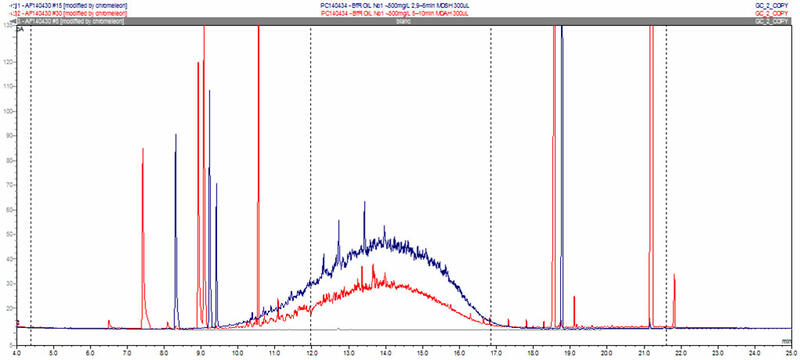
Mineral oil hydrocarbons (MOSH and MOAH)
Papers and boards in contact with foodstuffs
- Quantifying and managing mineral oil hydrocarbons (MOH)
- Analysing the migration of the various MOSH and MOAH families
General informations
It has been known for several years that mineral oils are present in foods: this can be due to both contamination from the environment and the intentional use of lubricants, additives or processing aids containing mineral oils throughout the food production chain. Contamination by packaging materials used during transport of raw materials or conditioning constitutes a third source.The potential toxicity of certain families of these molecules requires increased vigilance. The CTP’s experience in this field will allow you to control the role played by packaging, and will guide you in choosing the tests to perform and in interpreting the results.
Technical Data and Achievements
MOH families and toxicity
A mineral oil is composed of a complex mixture of thousands of hydrocarbons, which are molecules made up exclusively of carbon and hydrogen with a variety of structures (cyclic, linear or branched) and chain lengths; its chemical composition therefore cannot be determined precisely. In addition, the nature and relative quantity of each of these hydrocarbons will define all the characteristics of a mineral oil, including its molecular mass, viscosity and dangerousness.
Mineral oil hydrocarbons (MOH) come from raw crude oil, coal, natural gas or biomass and are composed of two main families, which are mineral oil saturated hydrocarbons (MOSH) such as paraffins or naphtenes, and mineral oil aromatic hydrocarbons (MOAH).
One solution to limit potential migration to foods is to choose suitable inks and glues, and another is to use paper and board materials with barrier properties where necessary.
Current regulatory framework
In its EU recommendation 2017/84, the EFSA has identified the sources of food contamination by MOSH and MOAH and has highlighted the role played by certain types of board packaging used for dry foods. A Europe-wide study is carrying out inter-
laboratory analyses in parallel with a toxicity study. In this context, ANSES has published an Opinion (Request no. 2015-SA-0070) specifying the definitions of compounds, the methods used for analyses and the existing toxicity studies. The German BfR proposes a method for determining MOSH/MOAH in dry foods. This data, which is updated regularly, is used by the CTP as the basis for its expertise.
Analyses performed at the CTP
The best analytical techniques are available to you at the CTP chemical analyses laboratory. Titration of mineral oil hydrocarbons takes place in 3 stages: extraction of the compounds using a specific blend of solvents, separation of MOSH and MOAH families by high-performance liquid chromatography (HPLC), then quantification of these families by gas chromatography with flame ionisation (GC-FID) detection. Identifying certain tracers by gas chromatography with mass spectrometry (GC-MS) detection allows extra information to be added to this quantification.
Titration can be performed to analyse the total content for a wide range of products:
- papers and boards
- additives and processing aids
- after specific migration directly from the material or through a barrier in simulant foodstuffs such as MPPO, iso-octane or 95% ethanol
- by cell or by immersion, depending on the type of material and contact.
- foods.
 |
| Chromatograms of MOSH/MOAH fractions |